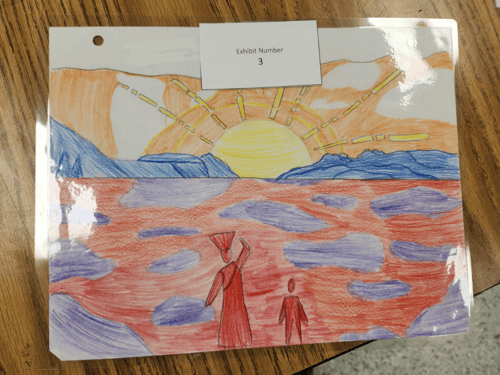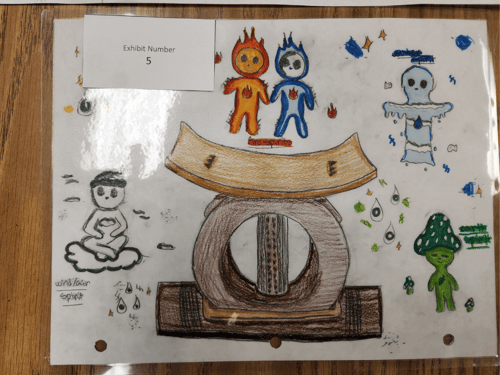Learn how Eli Rollman, a 7th-grade social studies teacher at Creekland Middle School in Cherokee County School District in Northwest Georgia, implemented STEM-based PBL focused on the 4 C’s and connecting content to real-world problem-solving.
“Why are we doing this?” You’ve probably heard your students ask this question before. Eli Rollman, a 7th-grade social studies teacher at Creekland Middle School in Cherokee County School District in Northwest Georgia has heard it plenty of times in his nine years of teaching, but he has heard it a lot less since he transformed his classroom five years ago. That’s when he became a teacher leader and shifted his focus to STEM, Project-Based Learning (PBL), the 4 C’s (critical thinking, creativity, communicating, and collaborating), and connecting his content to real-world problem-solving.
While Eli has been teaching 7th-grade social studies his entire teaching career and all 9 years have been at Creekland, he constantly challenges himself to modify and improve his curriculum. Perhaps it’s because, as he says, he “got into teaching late,” taking seven years to get his bachelor’s degree while coaching middle school football. He spent his college years taking history classes “with no end in sight,” but realized he enjoyed working with middle school students, watching the kids get better every day. When it came time to choose a specialty, he picked science because he already had enough social studies credits to qualify for a minor. It was a surprise when he landed his first job as a social studies teacher, but he’s never looked back, even meeting his wife at Creekland. His course covers the Middle East, Eastern Asia, and Africa, religions and geography. “I was preparing without even knowing,” Eli says. “This is what I’m meant to do.”
Eli grew up in a similar community in nearby Forsyth County Georgia. The students are mostly middle class and white, with a small, growing population of English Speakers of Other Languages (ESOL) learners. His course provides an important opportunity to expand the student’s cultural awareness and empathy for people of other places and times. Helping Creekland obtain their STEM certification changed the way he taught. His approach used to be, “Let’s read about it, let’s talk about it, let’s talk about it. Like I learned.” Now he’s shifted everything he teaches to a real-world problem, taking his students through an inquiry process. He’s learned to use pictures, videos, and real-world articles to connect what he is teaching to a problem we face today. “I’ve flipped my social studies classroom from direct instruction to having my students create an authentic product. They create the product as they are learning.” Since then, the students rarely ask “Why are we doing this?” and when they do, Eli feels better able to answer the question when he does get it. “I can say, here is a problem we are facing in the world. The students are more accepting, more willing and engaged and they learn more.”
One advantage Eli has is that his course does not end with a state assessment. He feels he has ample time to dedicate to an inquiry process, spending as much time as his students need on something. “I’m not as worried about them learning facts as I am about them learning themselves. I want them to learn to solve problems and draw conclusions. I used to want them to learn about the structure of the government of Saudi Arabia. Now I want them to be able to compare the structure of the government of Saudi Arabia to the structure of the United States.”
While his classroom has transformed in many positive ways, his practice is not without challenges. One in particular stands out. He still struggles not to be too vague with directions. “I have to try not to tell them what they need to know, to find that happy medium. It’s a constant struggle.” One solution he’s found is to conference with individual students where he provides some structure for how he will assess the students. This way he can allow choice and freedom without driving himself crazy! For example, students completed a project where they pitched why a particular location was the best place to start a business. When students asked what they should create, his answer was “Whatever you want!” He finds that the more freedom students have, the more they are interested, but conferences allow individual students to feel supported.
Another challenge is sharing technology. Eli shares resources with other teachers and has about a 2:1 device-to-student ratio, with students bringing in their own devices. Using a learning management system helps students stay organized, but he recently started using Defined Learning to level up with PBL in his classroom. “I love how Defined Learning takes a topic and connects it to a career. Then you have an authentic product connected to that career. I struggle with that. I can connect [my content] to a real-world problem, but what career path does it connect to? Defined Learning has helped me with that.” Eli will go on the site to find out about careers not even related to his content area just to be able to make connections for his students. “It’s not scripted, so you can change it and make it whatever you want. I take a broad topic that relates to what we’re doing and keep the final product and career connections because that’s what I have the hardest time coming up with on my own. I used Defined almost like a graphic organizer for myself, as the teacher, for how I can put it all together.” For example, Defined Learning has a task about flooding in a South American community. Eli’s course content talks about flooding in India and China so he revised the task to align with his course.
Eli is in his second year using Defined with his students. He still scaffolds the students’ experience when using the resource. He has the students individually log in to the task while also sharing it with them on a screen, alternating between whole group instruction, small group discussion, and individual research. He creates questions for the resources and spends time modeling for the students, especially the first time they complete a task. “I chunk it up for them. We do it together. I show them how to access the site, explain the directions, and then give them time to collaborate and talk to each other, which takes about 30-40 minutes. It’s not difficult, but it is new. Once they get it, they get it quickly. By the second time, I can give them a sheet that shows what slide they are on and tell them how much time they have to do each slide, then bring them back together to talk it through.”
Since he started using Defined, Eli has noticed much higher engagement in his classroom. “They understand the why. They’re more interested and connected to the problem. They understand how the information is actually useful to them.” He also has more time to talk with students, listening to them talk and observing and questioning them as they collaborate. From those observations, it’s clear students are meeting the success criteria.
One success story Eli and his students are particularly proud of is their work on a task called Freelance Artist. The students created an art gallery that allowed them to compare and contrast African cultures. The students observed each other's work, naming the cultures they observed and explaining how they knew the work came from each culture. In the past, this unit was relatively traditional, with students taking notes on each culture and memorizing facts. This time, students created amazing artwork from infographics to play-doh models of Bantu masks, cave paintings, and even a stool, traveling around the room writing down facts. “It was such an interesting way to learn and created so much interest about these cultures.” Eli beamed with pride as he shared examples of his students’ work. He’s already thinking of ways to remix this project for the current school year to keep the curriculum engaging and relevant for his students!

